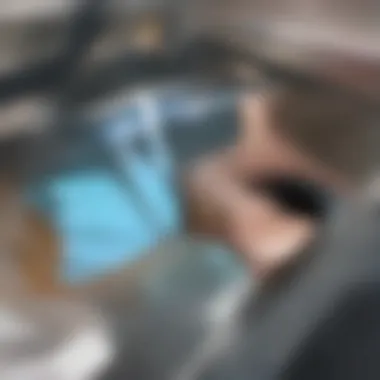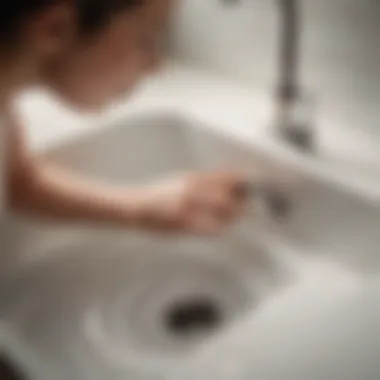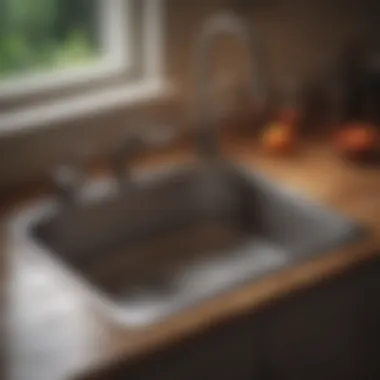Mastering the Art of Snaking Your Kitchen Sink


Intro
Dealing with a clogged kitchen sink can be a frustrating experience for any homeowner. Often, we encounter issues that seem small at first, but can quickly escalate into significant inconveniences. Understanding how to effectively snake a kitchen sink not only helps in resolving these clogs but also empowers you to handle such plumbing challenges more confidently. This guide will provide you with the essential techniques and tools necessary for snaking a kitchen sink.
Importance of Snaking a Kitchen Sink
Snaking a kitchen sink is crucial not just for immediate relief from water backup but also for ensuring proper drainage in the long term. Many people may not realize that regular maintenance can prevent build-up that leads to more severe blockages. By gaining knowledge through this guide, homeowners can take proactive steps to maintain their plumbing systems. This makes your home more functional and efficient.
The goal here is to demystify snaking techniques, discuss commonly encountered issues, and outline when it might be best to consult a professional plumber. With this comprehensive understanding, you'll feel prepared to tackle frequent kitchen sink problems without feeling overwhelmed.
Prelude to Kitchen Sink Clogs
Kitchen sink clogs are a common household issue that many people face. Understanding this topic is essential as clogs can lead to more significant plumbing problems if not addressed timely. Knowledge of how clogs form, as well as their potential causes, empowers homeowners to take proactive measures. This article aims to shed light on this issue, arming readers with the information needed to deal with clogs effectively.
Understanding Clogs
Clogs occur when there is a blockage in the drainage system, preventing water from flowing freely. This blockage can be created by a buildup of materials like food particles, grease, soap scum, or hair. When water cannot pass through the pipes properly, it results in slow drainage or complete stoppage. It is crucial to recognize that clogs can develop gradually, and regular maintenance may mitigate future issues. Understanding the nature of clogs helps individuals discern when it is time to take action.
Common Causes of Clogs
There are various reasons why kitchen sink clogs occur. Some of the most frequent causes include:
- Food Waste: Disposing of food scraps down the drain can quickly lead to blockages.
- Grease Accumulation: Cooking oils and fats solidify in pipes, creating a thick layer that traps other debris.
- Foreign Objects: Items that accidentally fall into the sink can obstruct the flow of water.
- Hair and Soap: Residue from soap and strands of hair often combine to form a dense clog.
Identifying these common causes can aid in taking preventive actions. Homeowners should be cautious about what goes down their kitchen sinks.
The Snaking Process Defined
Understanding the snaking process is essential for dealing with kitchen sink clogs. This section delves into what snaking involves and provides context for when it should be applied. A well-executed snaking process can effectively dislodge stubborn blockages. However, recognizing the right moments for snaking can prevent further damage to plumbing systems and save on costly repairs.
What is Snaking?
Snaking, in the context of plumbing, refers to the use of a flexible auger to clear obstructed drains. The tool, commonly known as a drain snake or plumbing snake, feeds into the drain line. As it is turned and pushed deeper into the pipe, the snake’s coiled end can latch onto debris or clogs.
Snaking is a method preferred by many DIY enthusiasts for its relatively straightforward approach compared to more invasive plumbing methods. Unlike hydro-jetting, which uses high-pressure water streams, or dismantling pipes, snaking is often less messy and does not require extensive setup.


While the snaking technique is relatively simple, it does require a basic understanding of plumbing systems to use correctly. Being informed of the positions and conditions of pipes helps in navigating the auger smoothly. Tackling clogged kitchen sinks efficiently is best done with the right mind-set and tools.
When to Snake a Kitchen Sink?
Identifying the appropriate times to snake a kitchen sink is crucial for effective plumbing maintenance. Some signs indicate that a snake might be necessary.
Indicators that indicate you should a snake your knitchen sink include:
- Slow Draining: If water is pooling in the sink or taking too long to drain, a blockage may be present.
- Frequent Clogs: If you experience multiple clogs in a short timeframe, it often suggests a larger issue in the plumbing system.
- Unpleasant Odors: Bad smells emanating from your sink may be caused by trapped food particles and waste.
Recognizing these signs early can make a significant difference in how easily a clog can be managed. It is advisable to address these issues promptly before they worsen and cause permanent damage to the plumbing system. If you are ever in doubt or if the problem does not resolve after attempting to snake the sink, it may be time to call in professional assistance.
"A proactive approach can save you time and money when dealing with plumbing issues."
Understanding the snaking process and its optimal timing can enhance your home maintenance skills. By adopting these techniques, you can avoid more significant plumbing challenges and maintain better overall hygiene in your kitchen.
Necessary Tools for Snaking
When preparing to snake a kitchen sink, having the right tools is crucial. The success of unclogging a drain often depends on the quality and type of tools used during the process. This section elaborates on the essential tools needed for snaking and their significance.
Types of Snakes
Different types of snakes are available, catering to various clogged conditions. Each type has unique features and benefits:
- Handheld Drain Snake: This is the most common tool. It is versatile and easy to use for minor clogs. The length typically ranges from 25 to 50 feet, making it suitable for most kitchen sink drains. You simply insert it into the drain and crank the handle to advance the snake into the blockage.
- Power Drain Snake: Best for more severe clogs. This tool is electric and can reach deep into the plumbing. Many models can handle larger debris, making it suitable for professional use or serious blockages. Though it requires more expertise, it can save time with stubborn clogs.
- Toilet Auger: While designed specifically for toilets, some might prefer this tool for heavy kitchen clogs. It features a rounded end to navigate bends in pipes, allowing better access to tough spots.
Selecting the right snake depends on the clog's severity and location. Understanding the differences can ensure you have the right tool for the job.
Additional Tools for the Job
Aside from a snake, other tools can enhance your ability to deal with clogs effectively:
- Bucket: Always handy to catch any water or debris that may flow out when opening the drain. It helps keep the area clean.
- Rubber Gloves: Protects your hands. The plumbing environment can be messy, and gloves keep you hygienic while working.
- Plumber’s Tape: Useful if you need to reassemble any plumbing sections after snaking. It helps ensure seals are tight and leak-free.
- Flashlight: A small, but valuable tool. Clear visibility of the drain area is important. A flashlight can help spot problems you might otherwise miss.
- Hair Catcher: Preventive measure. After unclogging, it is wise to install a hair catcher to help prevent future clogs, especially in kitchen sinks.
These tools play supportive roles while snaking a sink. Their inclusion can make the process smoother and ensure that you prepare adequately for any situation.
Step-by-Step Guide to Snaking a Kitchen Sink


Understanding how to snake a kitchen sink is essential for every homeowner. This process allows one to tackle clogs effectively without professional assistance, saving time and money. A systematic approach helps ensure that all crucial steps are followed, which enhances the likelihood of successfully clearing the blockage. Furthermore, it equips individuals with practical skills for future plumbing issues.
Preparing the Area
Before starting the snaking process, it is important to prepare the area around the kitchen sink. Clear off any items from the countertop and sink. This not only provides more space for movement but also keeps fragile items safe from potential water splashes. Next, place a bucket or container beneath the sink's drain. This will catch any debris or water that might spill during the snaking procedure. It’s wise to wear gloves during this stage to maintain hygiene, especially if the drain is quite clogged.
Accessing the Drain
Accessing the drain is a critical step in the snaking process. Underneath the sink, remove any pipe coverings or fittings using a wrench. If your sink has a garbage disposal, the process might require additional steps to remove any clogs present in that system. Ensure the area is unobstructed and that you can reach the trap—a curved pipe section that often holds debris. Once exposed, you can inspect it for visible clogs before proceeding. If the clog is not easily accessible, a snake will be necessary.
Inserting the Snake
With access to the drain established, the next step is inserting the snake. A plumbing snake, or auger as it is often called, should be carefully fed into the drain line. Insert the snake slowly, ensuring that it doesn’t damage the pipe interior. The snake’s end has a coiled design, which aids in grabbing and breaking up clogs. As you push the snake deeper into the drain, apply light pressure and avoid forcing it too much to prevent damage to the pipes.
Cranking the Snake
Cranking the snake is a crucial action that allows the tool to effectively break through the clog. As the snake is inserted, begin twisting the handle to rotate the snake's head. This motion creates a scraping effect against the blockage. Depending on the severity of the clog, this might take several minutes. It’s essential to pay attention to the feedback from the snake; if it feels like it has caught something, continue cranking until resistance lessens. This helps ensure that the blockage is adequately addressed.
Removing the Snake
Once you feel that the snake has effectively dealt with the clog, it is time to remove it. Carefully pull the snake back out from the drain, taking care to clean off any debris that might stick to it. This ensures that the debris does not fall back into the pipe. Discard any collected material properly, either in a trash bag or in a facilities designated for waste disposal. After this step, it is advisable to run hot water down the sink for a few minutes to wash away residual debris and check if the water flows freely.
Remember, regularly checking your kitchen sink for clogs can help you avoid major issues in the future. Maintenance is key to prolonging the life of your plumbing.
Preventive Maintenance Tips
Preventive maintenance is essential in ensuring the longevity and optimal functioning of your kitchen sink. By adopting regular maintenance practices, homeowners can significantly reduce the likelihood of clogs and other plumbing issues. Taking proactive measures not only saves time and money in the long run but also promotes a clean and functional kitchen environment. This section discusses effective strategies for keeping your kitchen sink in top condition.
Regular Cleaning Practices
Keeping your kitchen sink clean and free of debris is vital for preventing clogs. Regular cleaning practices can take various forms, including:
- Daily Rinsing: After using the sink, rinse down food particles and residues to prevent buildup.
- Weekly Deep Cleaning: Utilize natural cleaners such as vinegar and baking soda. Pour a cup of baking soda down the drain, followed by a cup of vinegar. This combination can help dislodge any potential clogs and eliminate odors.
- Strainer Usage: Using a strainer helps catch food scraps and debris. This simple tool can prevent larger particles from entering the drain.
- Avoiding Chemical Drain Cleaners: While tempting, harsh chemical cleaners can damage pipes over time. Opt for natural or mechanical solutions instead.
Adopting these habits can maintain a clearer drain and enhance the overall sanitation of your kitchen sink.


Avoiding Common Mistakes
While many homeowners try to care for their sinks, certain common mistakes can lead to more serious issues. Being aware of these can help in effective maintenance:
- Ignoring Small Clogs: Small slow drains should not be overlooked. They can escalate if not addressed promptly.
- Overloading the Sink: Avoid putting large amounts of food scraps down the drain. This can lead to significant clogs. Instead, dispose of waste in a compost bin or trash can.
- Misusing the Garbage Disposal: If you have a garbage disposal, be mindful of what you put down. Avoid fibrous foods like celery and starchy items like potato peels which can cause jams.
- Delaying Repairs: Address any leaks or signs of wear promptly. Procrastinating repairs creates bigger issues that may require professional help.
By complying with these preventive maintenance tips, homeowners can enjoy a functional and efficient kitchen. Regular care leads to fewer plumbing emergencies and ensures a cleaner workspace.
When to Call a Professional
Deciding when to call a professional plumber can be daunting, especially for homeowners inexperienced with plumbing issues. However, recognizing the right moment to involve an expert is crucial for several reasons.
First, attempting complex plumbing tasks without sufficient knowledge or tools can lead to more significant problems, resulting in costly repairs. Furthermore, professionals possess the necessary skills and equipment to address complicated issues efficiently and effectively. Understanding the signs that indicate the need for expert help is essential for maintaining a functional kitchen.
Signs You Need Expert Help
Several indicators can signal that it is time to call a professional plumber regarding your kitchen sink. These signs often reflect underlying problems that may not be visible to the untrained eye:
- Persistent Clogs: If you find yourself repeatedly snaking the sink without any lasting relief, this suggests a more severe obstruction or plumbing issue that requires expert investigation.
- Backflow Issues: If water frequently backs up in the sink, it could be due to a blockage deep in the plumbing system or a problem with the main sewer line. This situation demands immediate attention from a professional to prevent further complications.
- Unusual Noises: Strange sounds, such as gurgling or bubbling, emerging from the sink can indicate trapped air or blockages that may need specialized tools for resolution.
- Leaking Pipes: If you observe water dripping from pipes or under the sink, do not ignore it. A professional plumber can identify leaks and repair them promptly, preventing potential water damage and molding issues.
- Slow Draining: A slow drain might seem trivial, yet it may hint at a growing problem. Rapid intervention can help avert a complete blockage.
"Ignoring plumbing issues can lead to severe damage and higher repair costs."
Choosing the Right Plumber
Once you decide to seek professional help, selecting the right plumber is paramount. The effectiveness of the service you receive hinges on your choice. Here are some key factors to consider when choosing a plumber:
- Experience and Credentials: A plumber with years of experience typically understands a wide range of issues and will have encountered various situations. Checking their certifications and licenses helps ensure you hire a qualified professional.
- References and Reviews: Seek recommendations from friends or family. Online reviews provide insights into the plumber's reputation and reliability.
- Service Offerings: Different plumbers specialize in various areas. Ensure the plumber you consider has experience handling kitchen sink issues, including snaking and other related maintenance.
- Cost Estimates: Before committing to any service, ask for estimates. A professional plumber should provide a clear and transparent breakdown of costs.
- Availability: Consider the plumber's response time and availability for emergencies. A reliable professional should be reachable and willing to assist you in urgent situations.
In summary, knowing when to call a professional is vital for maintaining your kitchen's plumbing. By recognizing the signs of trouble and taking the time to choose a qualified plumber, you can protect your home from unnecessary stress and expense.
Ending
In this comprehensive article, we have explored the intricacies of snaking a kitchen sink, shedding light on the essential techniques and tools available to homeowners. Understanding this process is crucial, not just for resolving immediate plumbing problems, but also for fostering a proactive approach to maintain sinks effectively. The conversation around snaking extends beyond mere unclogging; it emphasizes the importance of regular maintenance and informed decision-making when faced with plumbing issues.
Recap of Key Points
- Understanding Clogs: Knowledge of the causes of kitchen sink clogs can empower homeowners to take preventive action.
- Snaking Defined: Snaking is an accessible method for clearing obstructions within the drainage system, and recognizing when to employ this method is key.
- Necessary Tools: Familiarity with the types of snakes and additional tools required can enhance the effectiveness of the snaking process.
- Step-by-Step Guide: A clear, methodical approach enables a successful unclogging of the kitchen sink, minimizing frustration and damage.
- Preventive Maintenance: Regular cleaning practices and awareness of common mistakes can help avoid future clogs.
- Professional Assistance: Knowing when to seek expert help ensures that more complex issues are resolved efficiently.
Final Thoughts on Sink Maintenance
Maintaining a kitchen sink is often overlooked, yet it plays a significant role in a home's functionality. Homeowners should recognize that being proactive in sink care can save time and expenses in the long run. Considering simple actions like regular cleaning or employing a snake when necessary can lead to significant improvements in overall plumbing health. This mindful approach will not only enhance the culinary experience but also preserve the home's structural integrity.
Ultimately, knowledge is power. By understanding the components that lead to clogs and the effective methods for addressing them, homeowners can approach sink maintenance with confidence and skill.















